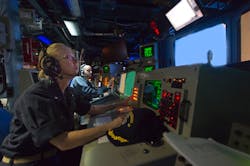Navy taps L3Harris for enhancements to shipboard and land-based communications networking technologies
SAN DIEGO – U.S.Navy tactical networking experts needed enhancements to Navy communications networks. They found their solution from L3Harris Technologies Inc. in Camden, N.J.
Officials of the Naval Information Warfare Center Pacific in San Diego announced a $7.9 million contract to L3Harris on Tuesday for enhancements to communications networks.
L3Harris-Camden has performed military networking infrastructure work such as the Navy Multiband Terminal (NMT) multiband capable satellite communications (SATCOM) system that provides protected and wideband communications.
The NMT is a next-generation SATCOM system for the U.S. and allied navies provides seamless assured connectivity between a ship's or submarine's computer network and the Global Information Grid.
L3Harris-Camden also builds the AN/USG-2B and AN/USG-3B sensors and weapons tactical networking equipment for the Navy Cooperative Engagement Capability (CEC) program aboard Navy surface warships and carrier-based aircraft.
The CEC is a tactical sensor and weapons network that uses Navy ships and aircraft for anti-air warfare. It combines information from sensors operating over wide geographic areas in a common tactical picture for battle groups at sea. It improves overall situational awareness, and enables fleet commanders to work closely together to attack enemy forces from long ranges.
L3Harris-Camden also handles the Navy Wideband Anti-Jam Modem (WAM), the Navy's next-generation wideband SATCOM modem that integrates with the Navy Multiband Terminal (NMT) on ships and submarines, and with the Modernization of Enterprise Terminal (MET) on shore for communications over the Wideband Global SATCOM (WGS) satellite constellation.
The company also is involved in the high-frequency (HFK) portion of the Battle Force Tactical Network (BFTN-HF) system. BFTN-HF works together with SATCOM and other global communications technologies to provide network connectivity for ships, submarines, aircraft, and naval shore sites via HF radio.
This HF communications mode uses radio frequencies between 2 and 30 MHz to bounce radio signals off the ionosphere to achieve over-the-horizon global voice and data communications. HF radio can be tricky to use because it is affected by constant changes in the ionosphere, by the seasons, and by the presence of thunderstorms. The BFTN system also has an ultra-high-frequency component called BFTN-UHF) for line-of-sight voice and data communications.
L3Harris-Camden also is involved with the Navy Consolidated Afloat Networks and Enterprise Services (CANES) project to provide computer hardware, software, spare parts, maintenance, cyber security, and laboratory equipment for ships and submarines.
On this contract L3Harris-Camden will do the work in Camden, N.J.; Salt Lake City; and San Diego, and should be finished by February 2025. For more information contact L3Harris online atwww.l3harris.com, or the Naval Information Warfare Center Pacific at www.niwcpacific.navy.mil.
